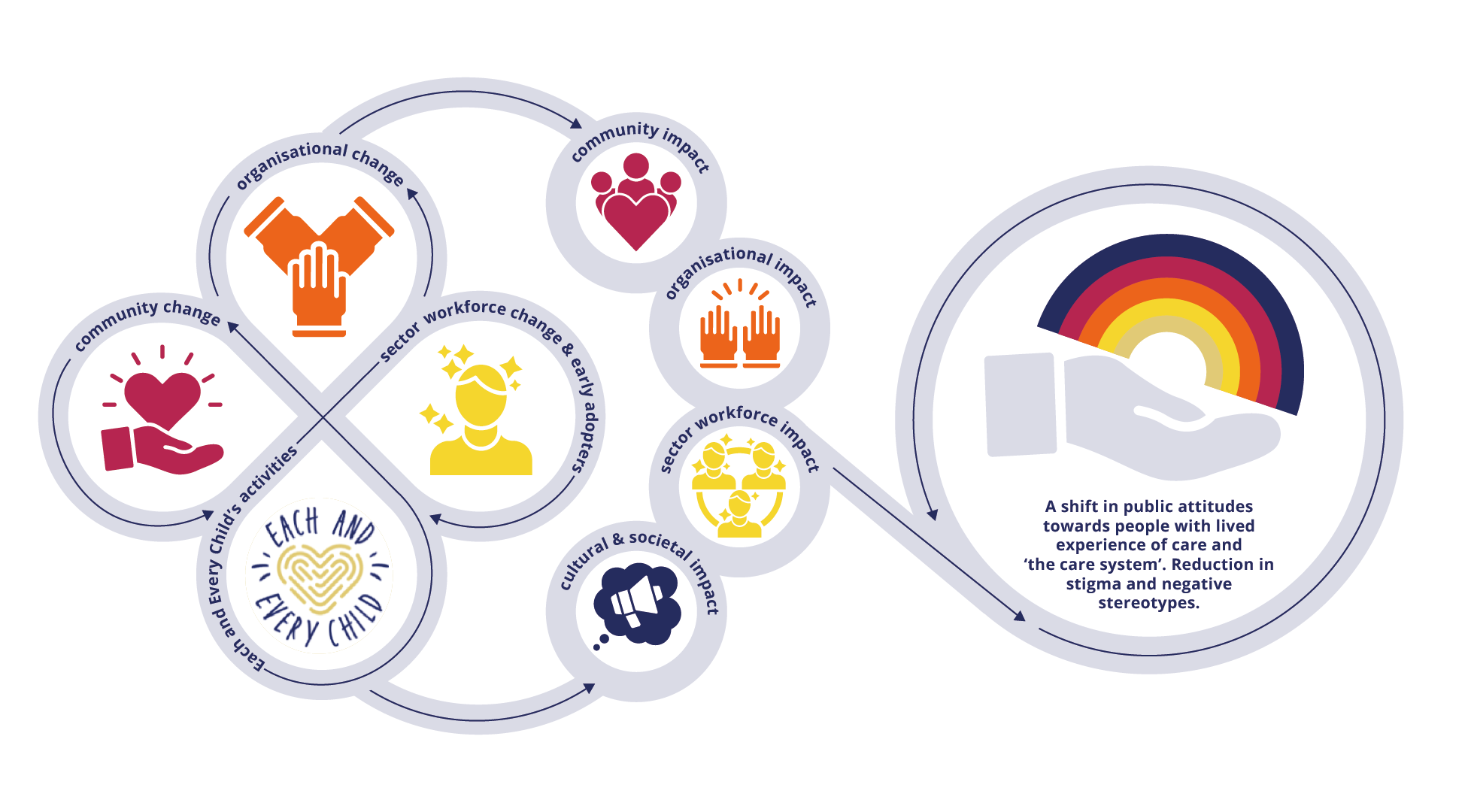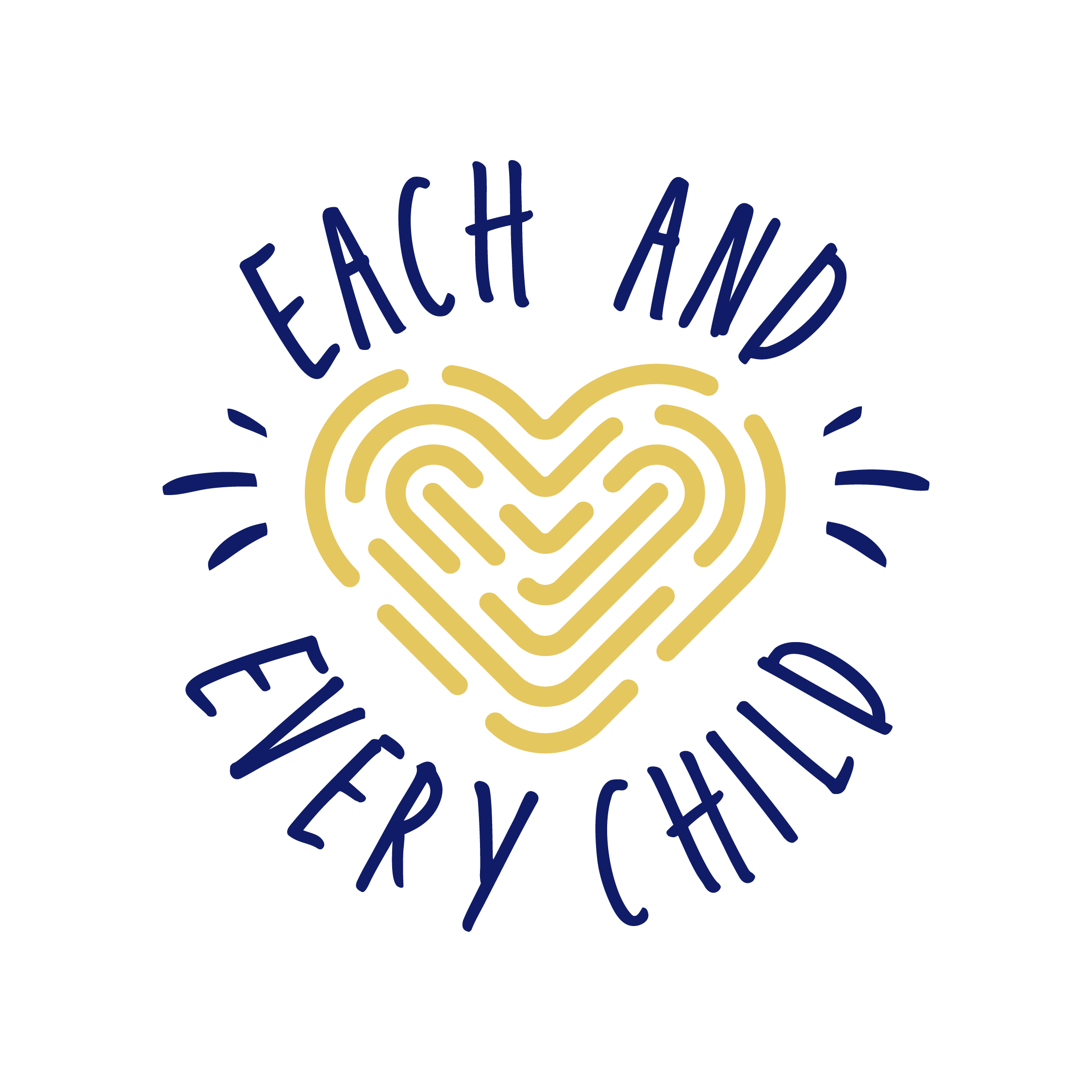
Each and Every Child – How will we shift public narratives?
The ultimate aim of Each and Every Child is to shift public attitudes towards people with lived experience of care and ‘the care system’. This will result in a reduction in stigma and negative stereotypes towards children, young people, adults and families with experience of care.
How will this be achieved?
To illustrate how the activities of the Each and Every Child initative aims to achieve this, we have created a Theory of Change. This theory of change shows us how our work will influence shift in the way we all think, feel and act that are needed to create change within organisations, the workforce and within the community.
Below is an explanation of what this diagram shows. For more detail on the theory behind this work, please see our detailed Theory of Change Narrative and diagram.
Theory of Change – In Detail

Each and Every Child Activities
The Each and Every Child initiative will focus on three areas of work – Voices of Experience, Early Adopters and sharing the framing recommendations with the wider sector to embed framing across the country. You can find out more about the activities here.
It is vital that people with lived experience of care are at the heart of all work to positively change the public narrative around the care system and the children, young people and families within it. The Voices of Experience work is central to every aspect of the initiative and will inform all areas of work.
When we talk about ‘the sector’, we are speaking about every individual and organisation that interacts with people who have lived experience of care. This includes statutory services (such as health, education, criminal justice, social work, housing), corporate parents, the third sector and private sector organisations, as well as friends, family and community members.
This initiative is about working with the whole community to affect change – everyone should feel included and able to contribute. We are all members of the general public, and we all must play our part in shifting narratives and tackling stigma.

Community Change
Each and Every Child will support people who have experience of care to explore the framing recommendations as tools that can be used when they are speaking about care and the care system. The initiative will co-design and co-facilitate framing sessions alongside people with experience of care. These interactive sessions will provide space for people to use the recommendations in their own way, to ask questions and to feed back into the initiative. This learning will then influence all aspects of the work of the initiative.
As a result of this work, people with lived experience of care will have ownership of the framing techniques when telling their (or a) story around care. People will be able to use the techniques to work towards their specific desired impact and help overcome stigma and discrimination without taking away individual agency. Framing is not about telling people what to say, but is a tool that people can use to create the impact that they want to see in a way that is safe for them to do so.

Organisational Change
Through engaging with framing, organisations should be confident to embed and use framing across their organisation and in all their communications. Our [Early Adopter] work will provide specific examples of what framing looks like in practice within strategic organisations that will aid and support others to explore the depth of the framing recommendations. This work will be shared by the Each and Every Child initiative.
As ambassadors for framing, Early Adopters will influence other organisations across the sector. In combination with the support offered by the Each and Every Child initiative through the framing sessions, organisations across the country will take ownership of framing, and use the resources authentically and naturally, in line with their own organisational language.

Sector Workforce Change
It will be crucial that leaders and the workforce understand the importance of embedding framing, feel confident in using the framing recommendations and the impact that language has, to adapt their own practice and advocate for further change. Through engaging with the Each and Every Child framing sessions and resources, individuals will feel empowered to use the framing recommendations in their own way, in and out of the workplace. The workforce will also advocate for framing with others, challenging and supporting others to frame alongside the recommendations.
As the diagram shows, all these different areas are linked and will influence each other as they engage with the Each and Every Child framing. As organisations and the workforce become more comfortable using and sharing their framing practice, this will lead to further embedding of framing across organisations and with colleagues. This will lead to a creation of a community of framers across Scotland.

Community Impact
Through the Each and Every Child initiative, and through people with lived experience using framing to tell their story, or a story, of care, public support for progressive change will increase at all levels, ultimately leading to less discrimination, less stigma and support for policies and legislation.
With stories being framed to tackle stigma and avoid negative perceptions, people with lived experience of care should feel safe, included, less alone, valued and listened to, and that their experiences, however diverse, are valid, important, and understood.
The general public will understand that everyone has a responsibility to ensure that their communities are inclusive of each and every child. And crucially, they will understand the actions that they need to take to achieve this, and will challenge attitudes, policies and language that is not inclusive.

Organisational Impact
Engaging with framing will lead to widespread progressive organisational change in language, communications, and behaviours, with organisations influencing each other to use framing as a standard practice, humanising care, and the care system. This will result in a reduction in stigma and stereotyping in wider society and more support for the progressive change that will improve the lives of all people with lived experience of care.
In addition, it will influence those who are decision makers within society, and will drive forward the uptake of progressive policies, with lived experience at the centre.

Workforce Impact
As more and more individuals experience the framing recommendations, through the support offered by Each and Every Child and, importantly, accessing support from colleagues and contacts who are advocating for this work, critical mass of shared narrative is reached across the sector workforce. This will influence the organisations that they work for, and feed into the organisational impact described above.
The impact on the workforce cannot be distinct from the impact on community, and the impact of people with lived experience exploring the framing recommendations. The aim is that all these impacts will come together to drive forward a shift in public attitudes through a reframed narrative, which is the ultimate aim that the initiative is working towards.

Cultural & Societal Impact
As the sector, the workforce, and people with experience of care explore and start to use the framing recommendations in all their communications, it is hoped that this will influence narratives within culture, society, and the media. Each and Every Child will specifically work with these areas to influence and raise awareness of the impact of framing.
With framing reflected in culture, society, and media, this will ultimately begin to shift the understanding of the general public and change their pre-conceived attitudes towards people with experience of care and the care system and build support for change.
Outcome
The ultimate aim of the initiative: to shift in public attitudes towards people with lived experience of care and ‘the care system’ and a reduction in stigma and negative stereotypes.
Our detailed Theory of Change Narrative explains more about how the initiative aims to achieve these impacts, including the assumptions that we have made for us to deliver the initiative, and what the unintended consequences of this work could be. It also goes into detail about factors that could help and hinder the uptake of framing, such as the pandemic, the stretched workforce, and the political landscape.
This Theory of Change will change and adapt to new opportunities, challenges and the development of the Each and Every Child initiative. It will be formally reviewed at the end of the initial three years (2024).
